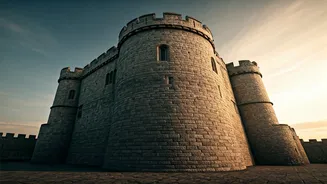Castle's Humble Beginnings
The construction of the castle, which began nearly a millennium ago, marked a significant period in architectural history. Initially, the castle served
as a defensive structure. Its strategic location was carefully chosen to provide optimal views of the surrounding territories. Master builders, employing rudimentary tools and ingenious techniques, worked tirelessly to bring the initial design to life. The castle's architecture reflected the prevalent styles of the era, which included robust stone walls and towering battlements. The builders took immense pride in their craftsmanship, understanding that this construction would need to withstand the test of time, enduring not only the elements but also potential sieges and wars. Through meticulous planning and execution, the foundation of a magnificent legacy was laid, forming the base of what the castle would become through the ages.
Royal Inhabitants' Lives
Throughout the centuries, the castle became home to various noble families and royal figures, each leaving their mark on its history. Within its walls, daily life was a tapestry of courtly rituals, strategic planning, and the everyday activities of a medieval household. The inhabitants’ lifestyles reflected their status and the period’s societal norms. Lavish feasts, grand celebrations, and the arts provided entertainment for the nobility, while the lower classes fulfilled duties of service, from tending to the castle's extensive grounds to fulfilling the needs of the ruling elite. The castle served not just as a residence, but as a center of power and cultural exchange. It witnessed many historical events that have become embedded in the history books, marking it as a critical site for the rise and fall of dynasties and empires.
Architectural Evolution
Over time, the castle underwent extensive architectural transformations. These changes were driven by various factors, from changing military requirements to aesthetic preferences influenced by changing times. Throughout the Middle Ages, the structure evolved to include fortified walls, defensive towers, and intricate gateways. Renaissance influences brought about luxurious additions like ornate courtyards and embellished interiors. The castle's architectural evolution showcases the ingenuity of its builders and the aesthetic shifts across different historical periods. Each alteration reflected the needs and aspirations of the inhabitants, and the evolving design tells a story of survival, adaptability, and the persistent human desire for comfort and beauty. The ongoing renovations through the ages ensured the castle’s endurance, transforming it from a mere defensive structure into a complex historical landmark that continues to captivate visitors.
Facing The Test of Time
The 900-year-old castle has weathered numerous challenges over the centuries, enduring sieges, wars, and the relentless forces of nature. Military conflicts left their scars on the castle walls, with arrow strikes, cannon impacts, and attempted breaches. However, through skillful defense and diligent repair, the castle survived numerous assaults. Environmental factors also took their toll, with wind, rain, and the passage of time leading to deterioration. Despite these challenges, restoration efforts and historical preservation have helped the castle remain structurally sound and retain its magnificence. These continuous conservation projects reveal a deep respect for the castle's history and its significance, ensuring that future generations can witness and appreciate its heritage. The structure stands as a testament to human resilience and a lasting symbol of the past's enduring influence.
A Living Museum
Today, the castle stands as a living museum, open to the public for exploration. Visitors can walk through its halls and courtyards, explore its towers, and learn about the individuals who shaped its narrative. Various tours, exhibits, and educational programs immerse visitors in the castle's history. Guided tours offer insights into the castle's architecture, its previous occupants, and the significant events that occurred within its walls. Exhibits display artifacts, historical documents, and other items related to the castle's past. Educational programs, such as historical reenactments, provide a deeper knowledge and a more engaging experience. The castle has become more than just a historical monument; it is a gateway for understanding the past, offering both education and inspiration to everyone who enters its ancient walls, thus creating a lasting impression.












